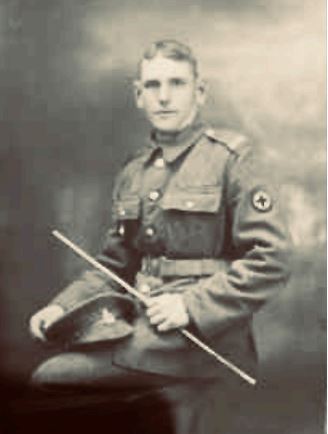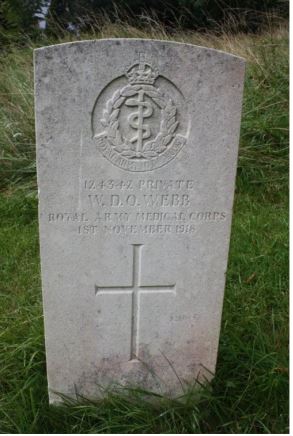Royal Army Medical Corps

This biography is the result of research on Ancestry and correspondence with family members — descendants of William’s children. The name ‘Orchard’ caused initial problems in research for both myself and the family.
William Dick Orchard Webb was the sixth of seven children born to Letitia and James Webb of Tower Street, Stroud. His Army Attestation Certificate, signed in August 1916, quotes his age as 29 years and two months therefore his birth was probably in June/July 1887. The Civil Register of Births Index shows a ‘William Richard Orchard’ (oddly, no Webb) being registered in the third quarter of 1887, which would match this date (if indeed these individuals are the same person). The Webbs had been hauliers for generations — actually coal merchants with the business stil carrying on today from Bisley Road in Stroud. The advert in Yellow Pages states ‘established over 100 years’. The 1881 Census states that James was also an inn keeper. By 1891, James was a lime burner and haulier and Letitia, a milk seller.
William married Rose Charlotte Ayres on 25 April 1912 at the Stroud Parish Church. The couple had four children: Robert William born 20 January 1913, Kathleen born 20 July 1914, Lillian Winifred born 5 December 1915 and Iris May born 19 March 1917. Iris died before her first birthday and was buried on 16 March 1918, but her elder siblings lived to good ages — 92, 86 and 80 respectively.
William’s service record has survived. Although William ‘attested’ for military service (for duration of the War) on 30 August 1916 (at Stroud) he was not mobilised until 15 August 1917 and was posted to the Royal Army Medical Corps (RAMC) on the following day, initially joining a training unit. It does not appear that he saw service abroad and for reasons unknown on 1 June 1918 he was transferred to 599th Agricultural Company, Labour Corps (acquiring a new Army number of 495161). Agricultural Companies usually received men whose fitness levels (due to wounds or infirmity) did not lend themselves to front line service and they were assigned to work on farms, etc. A B178 Medical History Form produced when William joined the Agricultural Company, indicates that he had a low fitness classification of B2. Possibly his lack of fitness became apparent during his period of training with the RAMC. His disciplinary record appears to be good — the only blemish being two days confined to barracks as punishment for ‘breaking out of ranks on the march’ on 1 November 1917.
William was admitted to the 2nd Southern General Hospital at Bristol on 20 October 1918, most likely a victim of the ‘Spanish Influenza’ epidemic of that time and he died of pneumonia on 1 November 1918; he was 31 years old. Rose, his wife had already succumbed to influenza, dying on 5 October. The family believe that Iris probably also died from influenza. Rose left £13 14s 6d to Charles Webb — her brother-in-law.
The family tell me that the eldest child, Robert went to live with an uncle (I suspect this was Charles), Kathleen went to Rose’s sister and the youngest, Lillian went in to care.
Army form W5080 — names and addresses of relatives of the deceased soldier, dated 17 December 1917 (which should be 1918) was signed by Sarah Brown, widow Rose’s sister. She named Charles as brother and although difficult to be sure due to the writing, Louisa as his sister. Both William’s parents were dead.
The entry in the Register of Soldier’s Effects is dated 28 January 1921. William had a credit of £11 9s 3d. Sarah Brown was awarded £1 16s 5d and the £4 16s 5d awarded to Eliza Loveday (possibly William’s sister although I cannot be sure) was returned for son Robert (pending his return from a home). Robert would have been seven or eight by this time. One of the family believes that Robert was a ‘cripple’ and was in care at Stoke Park Hospital in Bristol so this may well be the ‘home’ referred to. It was known as Stoke Park Colony and housed children with mental illness or a learning difficulty.
William’s probate details appear on the same page as that of his wife. It is dated 23 March 1919 with £589 2s being awarded to his brother Charles.
William was buried in Stroud Old Cemetery, where a standard CWGC headstone (bearing the insignia of the RAMC) now marks his grave.
There is a photo of both William (in uniform) and Charles on Ancestry submitted by the family.

Researched by Helen Wollington 27 December 2016
